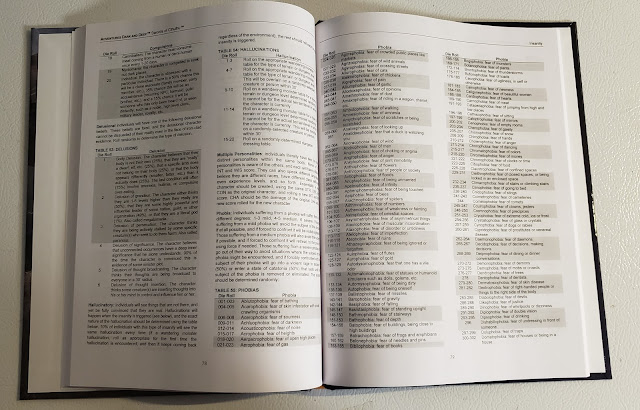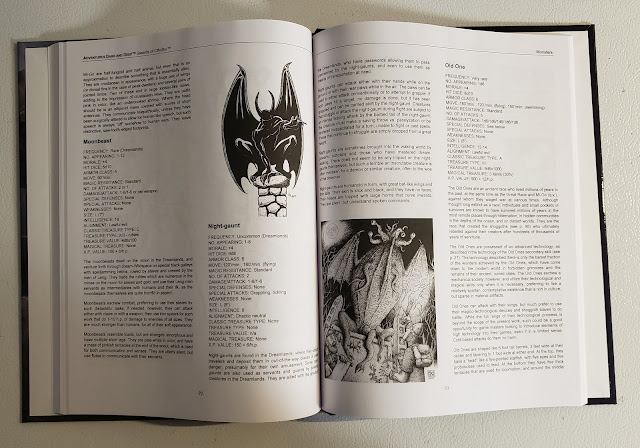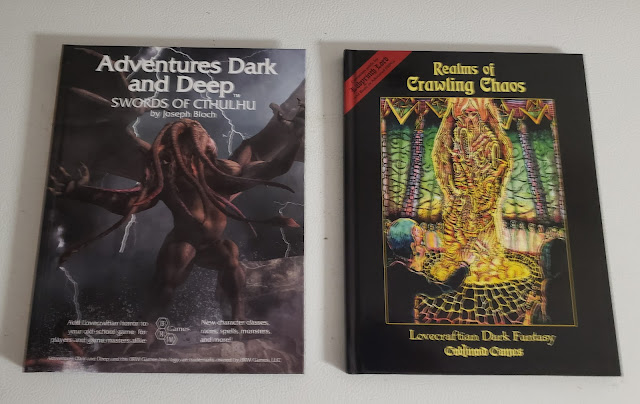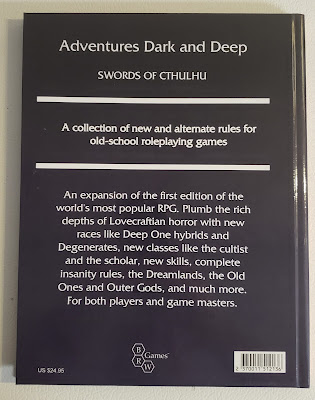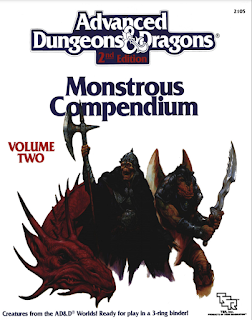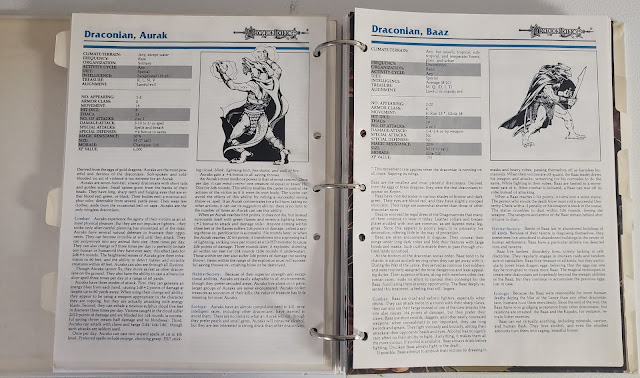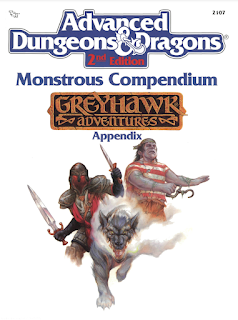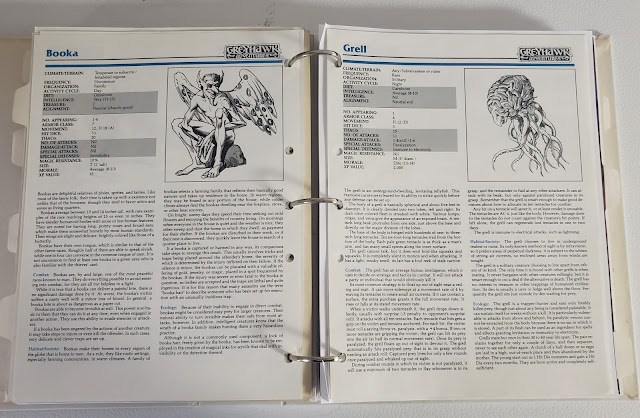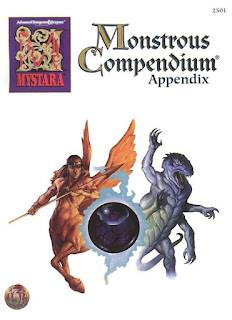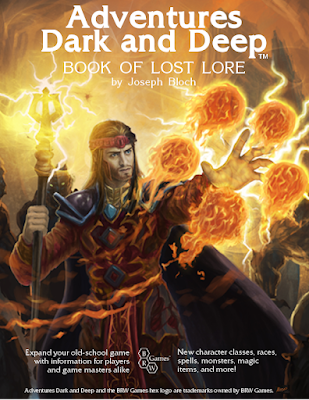There is a lot to unpack here so lets get to it.
For this review and deep dive, I am going to focus on the PDF and Print on Demand, I got from DriveThruRPGvia backing the Kickstarter.
The book is set up much like all the Adventures Dark and Deep books for "1st Edition." This includes his Book of Lost Beasts and Book of Lost Lore. One might wonder why this isn't the "The Book of Lost Cthulhu."
The book has the "1st Ed" Orange spine and layout and is a proper 128 pages. If the goal here is to feel like a book that would have been in your book bag in 1986 then I would say it was a success.
Like the BRW's previous "Books of" this one is for 1st Edition AD&D but no mention of that game is found here. There are oblique references to it, but nothing say to the level we saw in Mayfair's AD&D products of the 80s and early 90s. Though like those previous two books there is no OGL and no Open Gaming content. So here are my thoughts on that. One, it doesn't affect the game playability of this book. Two, given that much of the Lovecraftian mythos are in the public domain this feels like a slight really, I mean using essentially IP for free but not giving something back. And three, there is so much of this already in the public domain AND released as Open under the OGL from other publishers it my all be a moot point. Still I am sure some OSRIC, Advanced Labyrinth Lord, or Old School Essentials Advanced might want to do some Lovecraftian-style adventures for "1st Ed." and this would have helped.
But enough of that. Let's get into what is in the book.
If you are familiar with AD&D 1st Ed, any part of the mythos, and/or BRW's Adventures Dark and Deep books then you could likely predict with a high degree of certainty of what is in this book. This is not a bad thing.
The spiritual godfather here is the Unearthed Arcana. The book gives us new races; the Deep One Hybrid and the Degenerate. These feel like they are right out of Lovecraft books, though I would argue that both races have issues moving outside of their realms. Deep One Hybrids away from water and Dagon for example.We get level limits for the new races with old classes and old races with new classes (not introduced just yet).
The new classes are the Cultist and the Scholar. The cultist gets different abilities depending on which cult they are in. Scholars are a "split class" starting out as Magic-users and then switching over to scholars. If you have the Book of Lost Lore then you can split class with the Savant. I would even argue that the Cleric would be a good choice if the cleric has a high Intelligence.
The is a Skill system, the same found in the Book of Lost Lore, and this recaps some of that and expands it. While again overtly for 1st Edition it could work anywhere, also it can be ignored for folks that do not want to use skills for their games.
Up next are spells. In the Cthulhu mythos books and tomes of occult lore and knowledge never lead to good things. These spells are part of that yes, but this is also an "AD&D" game and not "Call of Cthulhu" magic serves a different purpose here. We get about 36 pages of spells. There is even an optional rule for human sacrifice that fits the tenor of the tales well.
There is a section on running a "Lovecraftian" game along with the tropes found in an AD&D game. These have been covered elsewhere, but this version fits this tome well. In particular how to mix demons in with the Lovecraftian mythos creatures. Something I have covered in my own One Man's God.
You can't do the Lovecraftian mythos and not deal with sanity. Now. I am going to be honest. The overwhelming majority of RPGs get sanity and insanity completely wrong. I say this a game designer and as someone with degrees in psychology (BA, MS, Ph.D.) and who spent years working as a Qualified Mental Health Professional for the State of Illinois who specialized in treating schizophrenics. How does this book do? This one introduces a new saving throw versus Insanity. Not a bad solution really. I will point out that "Insane" is largely a legal definition. "Madness" would be a better term of choice here.
The definitions and descriptions used for the various modes of insanity (keeping with the book) are fine. We are not trying to emulate the DSM here. Though "Schizoid" is off. What is described there is more of a compulsion disorder. The Mulitple Personality one is always going to be problematic and I personally would drop the occurrence to more like 1 or 2%; even 3% is too high. I would re-do it as something akin to a "fractured" personality. It is a usable system, but it lacks the integration of the SAN system of Call of Cthulhu. Though this is understandable. Side note: I always look for "dementia praecox" in the list of insanities. When I see that and it is used properly I know the developer did their homework. It is not here and I had hoped it would be.
Up next we get to what is really one of the big reasons people want a book like this. The monsters.
There are about 30 monsters here in AD&D 1st Edition format. If you use nothing else in this book then this is pretty fun stuff. The art is good and works well here.
This is followed naturally by the magic items. Plenty of books and tomes to terrify players and delight GMs. Yes, the Necronomicon is here.
Ah. Now we get to the stars of the show. The main course of this seven-course meal. The gods.
All the usual suspects are here and the format is familiar to anyone that has read the Deities & Demigods. IF playability is your largest concern then yes this book WILL replace the 144-page Deities & Demigods for you. No more having to lurk on eBay or hope for that rare score at Goodwill. The stats are not exactly the same, nor should they be, but they are what I think many would expect them to be.
We end with an Appendix of suggested reading (a must really) and lists of random tables.
The PDF is currently $9.95 and the hardcover is $24.95. Perfectly within the price I would expect for this.
Now before I render my final judgment on this one a few more things.
I don't think it is unreasonable to ask "What does this book have that others do not?" For starters, it is developed specifically for AD&D 1st ed. I will point out that we do have plenty of other books, games, and resources that also do this for other OSR games and their relatives as well. Conversion is a matter of personal taste.
Briefly here are the main Lovecraftian/Cthulhu Mythos-related games/products I pulled from my shelves for this and how they compare. I am going to focus largely on the monsters and gods since that is the most common element.
Table of Cthulhu
- DDG = Deities & Demigods
- SoC = Adventures Dark & Deep Swords of Cthulhu
- RoCC = Realms of Crawling Chaos (Labyrinth Lord)
- ASSH = Astonishing Swordsmen and Sorcerers of Hyperborea (Only including Cthulhu/Mythos creatures)
- CoC d20 = Call of Cthulhu d20 edition
- SP CM5 = Sandy Petersen's Cthulhu Mythos for 5th Edition
- WSH = What Shadows Hide
In most cases, I am restricting myself to the "Core" Mythos creatures and the ones I really like. Some names are different, but I will try to go with the common names.
| Of Gods | DDG | SoC | RoCC | ASSH | CoC d20 | SP CM5 | WSH |
| Cthulhu | Y | Y | Y | Y | Y | Y | |
| Abhoth | Y | Y | |||||
| Atlach-Nacha | Y | Y | |||||
| Azathoth | Y | Y | Y | Y | Y | Y | |
| Chaugnar Faugn | Y | Y | |||||
| Cthuga | Y | Y | Y | ||||
| Dagon | Y | Y | Y | Y | |||
| Ghatanothoa | Y | ||||||
| Hastur | Y | Y | Y | Y | |||
| Hydra | Y | Y | Y | Y | |||
| Ithaqua | Y | Y | Y | Y | |||
| Mordiggian | Y | ||||||
| Nodens | Y | ||||||
| Nyarlathotep | Y | Y | Y | Y | Y | ||
| Shub-Niggurath | Y | Y | Y | Y | Y | ||
| Shudde M'ell | Y | ||||||
| Tsathoggua | Y | Y | Y | Y | |||
| Yig | Y | Y | Y | ||||
| Yog-Sothoth | Y | Y | Y | Y | Y | ||
| & Monsters | |||||||
| Ape, Devil | Y | Y | |||||
| Bhole | Y | Y | |||||
| Beings of Ib | Y | Y | |||||
| Bokrug | Y | Y | |||||
| Byakhee | Y | Y | Y | Y | |||
| Cave Beast | Y | ||||||
| Colour Out of Space | Y | Y | Y | ||||
| Crawling Reptile | Y | ||||||
| Cthonian / Spawn of Cthulhu | Y | Y | Y | Y | |||
| Deep One | Y | Y | Y | Y | Y | Y | Y |
| Deep One Hybrid | Y | Y | Y | Y | Y | ||
| Dhole | Y | Y | Y | ||||
| Dimensional Shambler | Y | Y | Y | ||||
| Flame Creature / Fire Vampire | Y | Y | Y | Y | |||
| Flying Polyp | Y | Y | Y | Y | |||
| Ghast | Y | Y | Y | ||||
| Ghoul | Y | Y | Y | Y | |||
| Great Race of Yith | Y | Y | Y | Y | Y | Y | Y |
| Gnop-Keh | Y | Y | Y | ||||
| Gug | Y | Y | Y | ||||
| Haunter in the Dark | Y | Y | Y | Y | |||
| Hound of Tindalos | Y | Y | Y | Y | |||
| Man of Leng | Y | Y | Y | Y | |||
| Mi-Go / Fugi from Yuggoth | Y | Y | Y | Y | Y | Y | Y |
| Moon Thing | Y | Y | Y | Y | |||
| Night Beast | Y | ||||||
| Night Gaunt | Y | Y | Y | Y | |||
| Primordial One / Elder Thing | Y | Y | Y | Y | Y | Y | Y |
| Rat Thing | Y | ||||||
| Serpent People | Y | Y | Y | Y | |||
| Shantak | Y | Y | Y | Y | |||
| Shoggoth | Y | Y | Y | Y | Y | Y | Y |
| Spider of Leng | Y | Y | Y | Y | |||
| Tcho-tcho | Y | Y | |||||
| Young of Shub-Niggurath | Y | Y | Y | Y | |||
| Voormis | Y | Y | |||||
| White Ape | Y | Y | |||||
| Y'm-bhi | Y | ||||||
| Zoog | Y | Y | Y | ||||
| Open Content | No | No | No | Yes | No | Yes | Yes |
It looks like Swords of Cthulhu fares pretty well, to be honest. No one book has everything. Now comparing anything to Deities & Demigods is a touch unfair since space in the D&DG was limited. Likewise comparing to Sandy Petersen's Cthulhu Mythos for 5th Edition (or Pathfinder) is also unfair for the opposite reason; it has so much and few people have written or said as much about the Cthulhu Mythos as much as Petersen has.
But comparing Swords of Cthulhu to say Realms of Crawling Chaos or Hyperborea is appropriate.
Realms of Crawling Chaos
These two books complement each other well. While there is a very, very slight difference in underlying system assumptions each one offers something the other lacks in terms of gods and monsters.
Hyperborea
Formerly Astonishing Swordsmen and Sorcerers of Hyperborea, this game is closer to AD&D than it is to Basic D&D and the tone of the world fits well. Where Hyperborea stands out in the inclusion of and the predominance of Howard and Ashton-Smith mythos as they relate to the Lovecraft ones. So lots of the same monsters and gods, but more Clark Ashton Smith. While Swords of Cthulhu gives advice on how to integrate the mythos into your "AD&D" world, Hyperborea gives us a world where they are integrated. What is the difference? In Hyperborea "sanity" is not really an issue since the mortals here already know of the gods and these creatures. Still, Hyperborea is not everyone's cup of tea.
I would argue that the combination of the three would give you the best Mythos game. Or maybe it would give *me* the best mythos game since I tend to lean into more Clark Ashton Smith tales than H.P. Lovecraft's alone.
Conclusion
Swords of Cthulhu is a great addition to the already crowded field of Mythos-related RPG books. No one book seems to have everything, and maybe that is fine really. If your game is AD&D 1st Edition and you want something a bit more than just what you get from the Deities & Demigods then this is your book.
If you play a lot of OSR games including their spiritual ancestors and you like the mythos, then this is also a fine book, but check with my table here to be sure you are getting what you want.
For things like "which is better 'Swords of Cthulhu' or 'Realms of Crawling Chaos'" it is a draw. Both do what they are supposed to do well. Both are good resources. SoC looks a bit better on the shelf next to all my AD&D books, but likewise, RoCC looks good on my Basic-era OSR shelf.
I vacillate on whether we have too many mythos-related RPG titles to thinking one more book won't hurt. Currently, the word "Cthulhu" produces over 5,450 titles on DriveThruRPG. So there is a market.
With so many choices you need to decide what fits well for your games. Swords of Cthulhu is a great choice but it is hardly the only choice.




